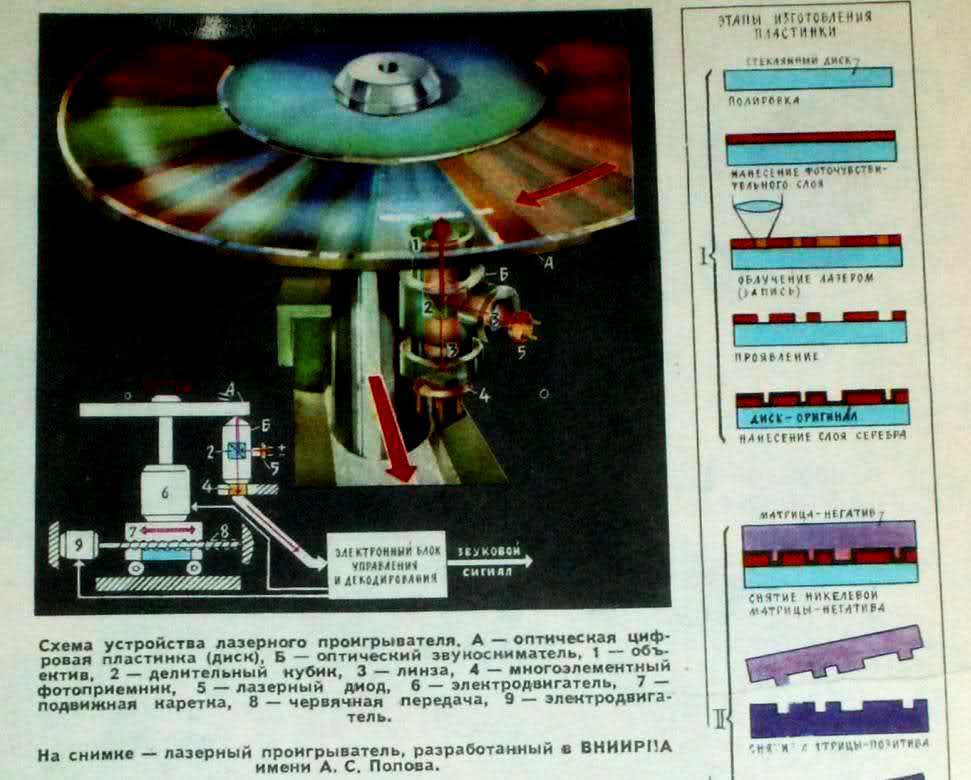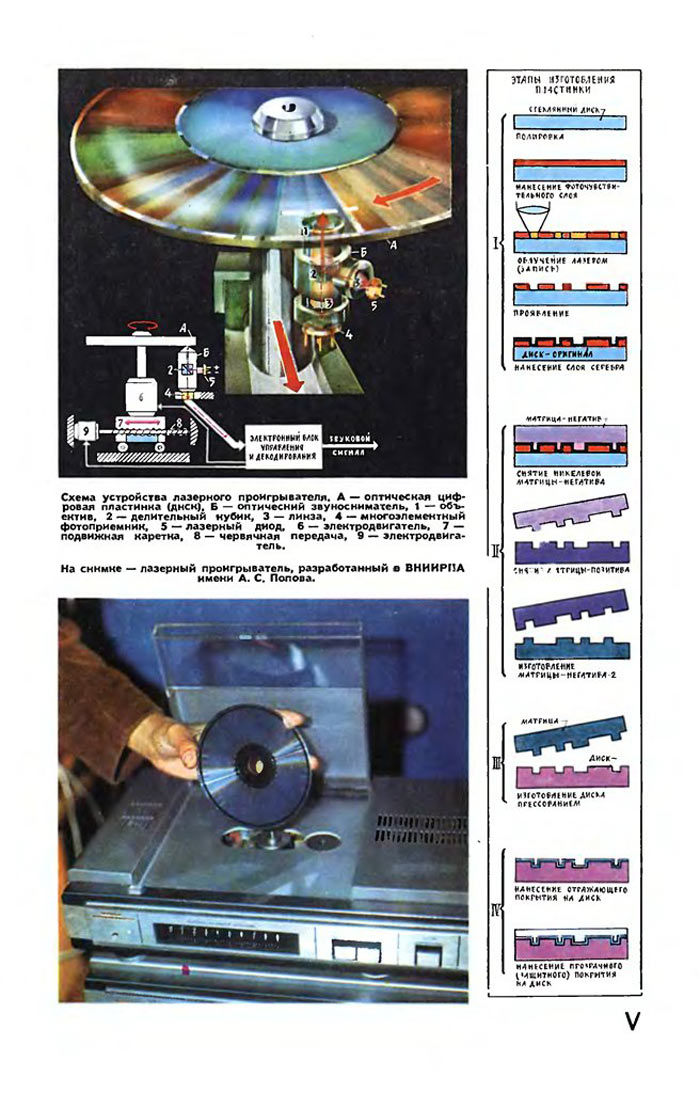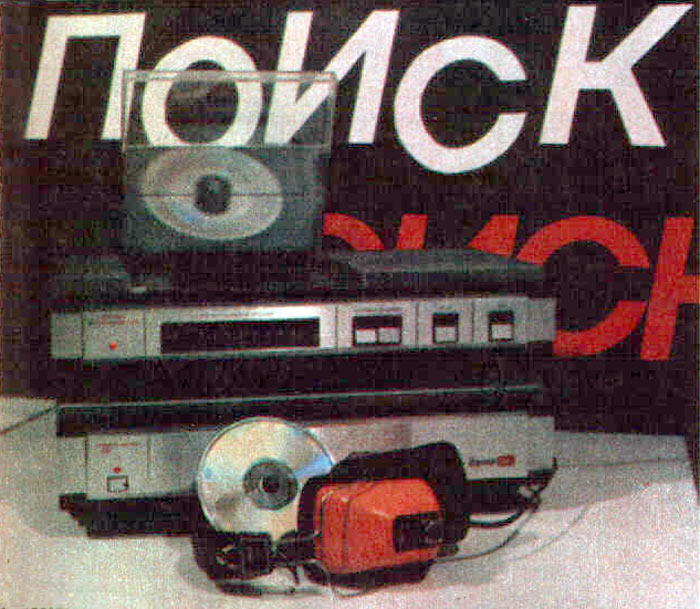Soviet HI-FI and its creators: digital sound recording in the USSR - one step away from victory
Not many people know that the USSR had its own program for creating digital audio formats and devices for their reproduction. It is likely that she could compete with the CD. In the past materials of this cycle I touched the first CD players created in the Estonian SSR. These devices were released 10 years after the appearance of the first prototypes in the United States, under the existing Western standard. Long before that, the Union was working to develop its own standard for digital recording.

The first prototypes of such a recording on an optical disc and a player for them were created a year before the appearance of the Philips serial device. And Soviet optical disk players, ready for serial production, were shown at the Exhibition of Economic Achievements almost simultaneously with the first production models in the West in 1982. Under the cut is the unknown history of the Soviet program for creating digital sound recordings.
For the sake of justice, it should be noted that the topic of the digital audio format of the USSR was not the first one and it was developed later than Philips and Sony corporations. It is known that the latter started back in 1970, while the party and government of the Land of Soviets issued the corresponding task only in 1975. It is not known for certain what caused the interest in digital transmission of audio data from decision makers and how it was planned to use digital sound recording. I would venture to suggest that not only civilian targets were pursued.
')
Anyway, for the development of digital audio format, as well as optical media and players for it, a special laboratory of specialists was created under the general guidance of E.I. Vologdina. A group of scientists and engineers were faced with complex and non-trivial tasks:
Search and development of technical solutions that will allow you to convert audio information into binary code, as well as record optical media and reproduce it without loss of quality.
Development of technical documentation, in particular the standard, for the organization of mass production of optical media and players for them at the enterprises of Soviet industry.
Creating recommendations for the Soviet enterprises to master the technology of mass replication of optical disks for digital recordings.
The project united prominent Soviet scientists and specialists in such fields as chemistry, optics, electroacoustics, mathematics, and computer science. Also an impressive contribution to the development was made by circuit engineers and designers, developers of automatic control systems, technologists and specialists in digital signal processing. The interdisciplinary approach and enthusiasm of the team ensured the project’s rapid progress.
For experiments on recording discs, it was necessary to organize a special clean room with an air purification complex to the level of no more than 100 dust particles per cubic meter.
One of the first problems that was confronted mainly by the laboratory chemists was the search for a chemical composition capable of changing under the influence of laser beams. It was necessary to create slabs with a certain shape and borders.
For experiments in this direction, a special chemical sub laboratory with a vacuum deposition section and an processing section of the exposed disks were equipped. As a result, the problem was solved, as it turned out later, in a manner close to that used on the first CDs.
A team of optics specialists was engaged in a laser beam focusing system that forms a spot of the required size. Engineers were faced with the challenges of automating the preservation of the distance between the lens and the surface of the carrier during recording and the radial movement of the recording lens.
Autofocusing, autotracking and engine management have become difficult problems in automatics. Their decision also took a significant amount of time. The main difficulty was the use of an LG-15 gas laser, which was a weighty 20-cm tube.
Such weight and size characteristics have left a significant imprint on the design of the player's servo systems, which was completely different from the modern one. The laser was fixed motionless, while the disk was mounted on a movable carriage.
A complex optical system consisting of mirrors, lenses and prisms was used to direct the laser beam. In the event of a reading error (tracking a track on a disk), it was not the laser, as in modern systems, that moved the carriage with the disk. Interestingly, a similar solution after 15 years was proposed by SONY engineers and called the marketing term "Fixed pick Up" mechanism.
Another challenge was the formation of a stream of information before writing to the media. It was important to understand how it is better to combine information into blocks and avoid errors during its transmission. In addition, it was necessary to determine with which code to modulate the data stream and how to achieve synchronization by blocks, symbols and bits. It took 1.5 years to solve the problem.
The first working laboratory prototype with the speaker name PKD "Luch-001" appeared in 1980. Until the end of 1981, he was diligently refined and fixed minor flaws. By 1982, the Soviet Union was fully ready for serial production of an optical disc player “Luch-002”.

Due to the fact that “Luch-002” was created on discrete elements, its overall dimensions left much to be desired. The player consisted of 2 blocks, in one there was a reading unit, control servo systems, a laser and a disk, in the second (lower) block there was a decoder and synchronization systems.
The “Luch-002” model, modified and fully prepared for serial production, with the first version of the Soviet optical disc with digital recording of a lyrical melody from the film “My Sweet and Tender Beast” was demonstrated at the Exhibition of Economic Achievements. The device was noticed by reporters of Leningrad television, and even a short local broadcast was enough to provoke a surge of interest from Soviet enterprises.
VNIIRPA began to be attacked by representatives of industrial enterprises wishing to launch a serial release of the player and master disc replication, among others were the giants of the Soviet radio-electronic industry and the Aprelevka record factory. When specialists of the enterprises received documentation - the enthusiasm instantly disappeared.
The reason for the sudden drop in interest in the new product from VNIIRPA was the impracticable requirements of technical documentation. In order to fully produce the player, enterprises had to organize the production of specialized LSIs, opto-mechanical units, to create suitable technological conditions.
Ideally, it was also assumed to master their own production of semiconductor lasers. For enterprises operating in a hulking planned economy with a heavy bureaucracy and a poorly motivated management, such tasks turned out to be impossible.

Meanwhile, the very technological possibility of implementing such a device for the industrial complex of the Soviet Union certainly existed, but not by the efforts of one particular enterprise, but by the combined efforts of several. It was important to cooperate with several factories of industrial associations, as was done with the production of complex products for the military-industrial complex.
Understanding this circumstance, the leaders of large associations began the struggle for the leading role in the project, since such a role promised to receive budget subsidies of the Union scale. Participants in the events describe this fight as fighting. Nobody wanted to give in, which ultimately led to irretrievable loss of time.
Already in 1982, Philips and Sony presented their own CD format as a serial international standard, the active distribution of CDs in the premium segment, and later among the masses, began. By the end of 1983, it became clear that the format had received worldwide recognition; at that time, the Soviet project had stalled in a hidden positional war. So the world market was irretrievably lost.
As a result, leading cadres in the government of the Union and the CPSU lost interest in the national digital recording. After perestroika in the USSR, they returned to the idea of a player, but not their own disks, but CDs that received worldwide distribution. Thus, the enormous work of the VNIIRPA laboratory was forgotten, and only some of their developments were in demand when creating the first Soviet CD transports, such as “Estonia LP-010”, “Estonia LP-001”, “Vega 122C”.
Jeans: We sell audio and video equipment, a lot, different. Acoustics, amplifiers, headphones, TVs, smart electronics, multi-rooms.

The first prototypes of such a recording on an optical disc and a player for them were created a year before the appearance of the Philips serial device. And Soviet optical disk players, ready for serial production, were shown at the Exhibition of Economic Achievements almost simultaneously with the first production models in the West in 1982. Under the cut is the unknown history of the Soviet program for creating digital sound recordings.
Start
For the sake of justice, it should be noted that the topic of the digital audio format of the USSR was not the first one and it was developed later than Philips and Sony corporations. It is known that the latter started back in 1970, while the party and government of the Land of Soviets issued the corresponding task only in 1975. It is not known for certain what caused the interest in digital transmission of audio data from decision makers and how it was planned to use digital sound recording. I would venture to suggest that not only civilian targets were pursued.
')
Anyway, for the development of digital audio format, as well as optical media and players for it, a special laboratory of specialists was created under the general guidance of E.I. Vologdina. A group of scientists and engineers were faced with complex and non-trivial tasks:
Search and development of technical solutions that will allow you to convert audio information into binary code, as well as record optical media and reproduce it without loss of quality.
Development of technical documentation, in particular the standard, for the organization of mass production of optical media and players for them at the enterprises of Soviet industry.
Creating recommendations for the Soviet enterprises to master the technology of mass replication of optical disks for digital recordings.
The project united prominent Soviet scientists and specialists in such fields as chemistry, optics, electroacoustics, mathematics, and computer science. Also an impressive contribution to the development was made by circuit engineers and designers, developers of automatic control systems, technologists and specialists in digital signal processing. The interdisciplinary approach and enthusiasm of the team ensured the project’s rapid progress.
The complexity of the process
For experiments on recording discs, it was necessary to organize a special clean room with an air purification complex to the level of no more than 100 dust particles per cubic meter.
One of the first problems that was confronted mainly by the laboratory chemists was the search for a chemical composition capable of changing under the influence of laser beams. It was necessary to create slabs with a certain shape and borders.
For experiments in this direction, a special chemical sub laboratory with a vacuum deposition section and an processing section of the exposed disks were equipped. As a result, the problem was solved, as it turned out later, in a manner close to that used on the first CDs.
A team of optics specialists was engaged in a laser beam focusing system that forms a spot of the required size. Engineers were faced with the challenges of automating the preservation of the distance between the lens and the surface of the carrier during recording and the radial movement of the recording lens.
Autofocusing, autotracking and engine management have become difficult problems in automatics. Their decision also took a significant amount of time. The main difficulty was the use of an LG-15 gas laser, which was a weighty 20-cm tube.
Such weight and size characteristics have left a significant imprint on the design of the player's servo systems, which was completely different from the modern one. The laser was fixed motionless, while the disk was mounted on a movable carriage.
A complex optical system consisting of mirrors, lenses and prisms was used to direct the laser beam. In the event of a reading error (tracking a track on a disk), it was not the laser, as in modern systems, that moved the carriage with the disk. Interestingly, a similar solution after 15 years was proposed by SONY engineers and called the marketing term "Fixed pick Up" mechanism.
Another challenge was the formation of a stream of information before writing to the media. It was important to understand how it is better to combine information into blocks and avoid errors during its transmission. In addition, it was necessary to determine with which code to modulate the data stream and how to achieve synchronization by blocks, symbols and bits. It took 1.5 years to solve the problem.
LUCH-002 - moments of triumph
The first working laboratory prototype with the speaker name PKD "Luch-001" appeared in 1980. Until the end of 1981, he was diligently refined and fixed minor flaws. By 1982, the Soviet Union was fully ready for serial production of an optical disc player “Luch-002”.

Due to the fact that “Luch-002” was created on discrete elements, its overall dimensions left much to be desired. The player consisted of 2 blocks, in one there was a reading unit, control servo systems, a laser and a disk, in the second (lower) block there was a decoder and synchronization systems.
The “Luch-002” model, modified and fully prepared for serial production, with the first version of the Soviet optical disc with digital recording of a lyrical melody from the film “My Sweet and Tender Beast” was demonstrated at the Exhibition of Economic Achievements. The device was noticed by reporters of Leningrad television, and even a short local broadcast was enough to provoke a surge of interest from Soviet enterprises.
VNIIRPA began to be attacked by representatives of industrial enterprises wishing to launch a serial release of the player and master disc replication, among others were the giants of the Soviet radio-electronic industry and the Aprelevka record factory. When specialists of the enterprises received documentation - the enthusiasm instantly disappeared.
Internecine deadlock in the maze of a planned economy
The reason for the sudden drop in interest in the new product from VNIIRPA was the impracticable requirements of technical documentation. In order to fully produce the player, enterprises had to organize the production of specialized LSIs, opto-mechanical units, to create suitable technological conditions.
Ideally, it was also assumed to master their own production of semiconductor lasers. For enterprises operating in a hulking planned economy with a heavy bureaucracy and a poorly motivated management, such tasks turned out to be impossible.

Meanwhile, the very technological possibility of implementing such a device for the industrial complex of the Soviet Union certainly existed, but not by the efforts of one particular enterprise, but by the combined efforts of several. It was important to cooperate with several factories of industrial associations, as was done with the production of complex products for the military-industrial complex.
Understanding this circumstance, the leaders of large associations began the struggle for the leading role in the project, since such a role promised to receive budget subsidies of the Union scale. Participants in the events describe this fight as fighting. Nobody wanted to give in, which ultimately led to irretrievable loss of time.
Inglorious final
Already in 1982, Philips and Sony presented their own CD format as a serial international standard, the active distribution of CDs in the premium segment, and later among the masses, began. By the end of 1983, it became clear that the format had received worldwide recognition; at that time, the Soviet project had stalled in a hidden positional war. So the world market was irretrievably lost.
As a result, leading cadres in the government of the Union and the CPSU lost interest in the national digital recording. After perestroika in the USSR, they returned to the idea of a player, but not their own disks, but CDs that received worldwide distribution. Thus, the enormous work of the VNIIRPA laboratory was forgotten, and only some of their developments were in demand when creating the first Soviet CD transports, such as “Estonia LP-010”, “Estonia LP-001”, “Vega 122C”.
Jeans: We sell audio and video equipment, a lot, different. Acoustics, amplifiers, headphones, TVs, smart electronics, multi-rooms.
Source: https://habr.com/ru/post/434616/
All Articles